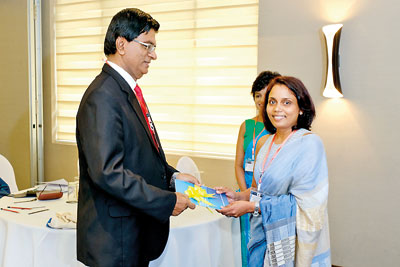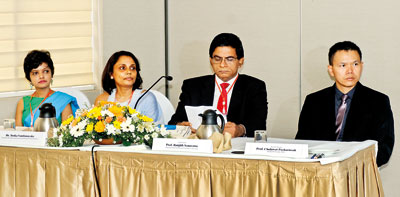News
Guidelines for care and use of lab animals launched
It was not just another scientific session, but a significant one for the welfare of laboratory animals.
For, the ‘Guidelines for the Care and Use of Animals in Laboratory-based Research in Sri Lanka’ were launched at the inauguration of the two-day Seventh Annual Scientific Sessions of the Sri Lanka Association for Laboratory Animal Science (SLALAS) on Thursday, amidst a distinguished gathering of local and foreign delegates at Hotel Renuka, Colombo 3.
SLALAS is the umbrella organization which brings together all researchers in Sri Lanka who have an interest in laboratory animal science.

SLALAS President Dr. Inoka Sandanayake presents the ‘Guidelines for the Care and Use of Animals in Laboratory-based Research in Sri Lanka’ to Chief Guest Prof. Ranjith Senaratne. Pix by Amila Gamage
The Guidelines detail the responsibilities of a team which undertakes such research and of the Animal Ethics Review Committees (AERCs) and institutions; how an animal facility should be maintained and how animals should be acquired.
They are expected to ensure the humane use of animals in Sri Lanka for the advancement of science through high quality research. The main animals used in research in Sri Lanka are mice, rats, guinea pigs, rabbits and zebra fish with the numbers being used roughly estimated to be around 2,000 to 3,000 per year.
Explaining the backdrop of animal experimentation, SLALAS President Dr. Inoka Sandanayake said that such experiments have been performed for several millennia across the world and as far back as 400 BCE by Greek scientists.
Closer in time to us, in 1955 Britain had used 1.8 million vertebrate animals in experiments which had increased to 5.53 million by 2018. More animal experiments are expected to take place due to genetic modifications such as CRISPR (Clustered Regularly Interspaced Short Palindromic Repeats), she pointed out.
The three prongs of laboratory animal science are the needs of society, the needs of animals and the needs of scientists, says Dr. Sandanayake highlighting the principles of laboratory animal science which have provided guidance for 60 years. They are the Principles of Humane Experimental Technique published in 1959 by William Russell and Rex Burch putting forward the 3R Concept of Replacement, Reduction and Refinement.
Focusing on the laws and bodies set up in connection with laboratory animals around the world, she said that Britain has the 1876 Cruelty to Animals Act; the United States of America – the Animal Welfare Act and Health Research Extension Act; the European Union – the European Directive 2010/63; Australia – the Code of Practices for the Care and Use of Animals for Scientific Purposes; Japan – the Law for the Humane Treatment and Management of Animals; Singapore – the National Advisory Committee for Laboratory Animal Research; and India – the Prevention of Cruelty to Animals Act 1960 and the Committee for the Purpose of Control and Supervision of Experiments on Animals.

The head table at the annual scientific sessions (from left) SLALAS Secretary Dr. Chamini Kanatiwela-de Silva; SLALAS President Dr. Inoka Sandanayake; Chief Guest Prof. Ranjith Senaratne; and Keynote Speaker Prof. Cholawat Pacharinsak.
In Sri Lanka, even though laboratory animals have been used in medical education since the 1950s and in research since 1969, legislation has not evolved with time. There is the Prevention of Cruelty to Animals Ordinance of 1907 and an Animal Welfare Bill which is yet to be passed.
Dr. Sandanayake reiterated that this is why the Guidelines are so important to provide a practical and ethical framework for decision making and to instil a sense of responsibility and accountability.
“These Guidelines are not designed to be used like a cookbook. One formula does not work for everybody. In some circumstances, the purpose of these Guidelines is to make adaptable recommendations. In resource limited settings, meanwhile, there is a need to identify how best the resources are used for the benefit of the society/country,” she added.
The contributors to the Guidelines launched on Thursday are Prof. Mangala Gunatilake of the University of Colombo; Dr. Mayuri Thammitiyagodage of the Medical Research Institute; Dr. Tharanga Thoradeniya of the University of Colombo; Dr. Inoka Sandanayake of the National Science Foundation; Dr. Chamini Kanatiwela-de Silva of Clinical Trials Unit of the University of Kelaniya; and Dr. Ureshani Karunarathna of the University of Sri Jayewardenepura.
The support team members were Dr. Samantha Iddamaldeniya of the Veterinary Research Institute; and Dr. Kalpani Ratnayake and Dr. Varuni Gunatilake of the University of Sri Jayewardenepura.
Earlier, a team from the Ethics Review Committee (ERC) of the Faculty of Medicine, University of Colombo and the Forum of Ethics Review Committees of Sri Lanka (FERCSL) had worked on ‘Guidelines for Ethics Review of Research Proposals Involving Animals in Sri Lanka’ which were published in 2009.
Thereafter, the Fifth Annual Scientific Sessions of SLALAS in 2018 had identified the need for comprehensive Guidelines for the conduct of research using animals. Subsequently, the National Science Foundation’s Working Committee on Bioethics had requested SLALAS to prepare Consensus Guidelines for the use of animals in research, with the first draft being discussed at the Sixth Annual Scientific Sessions in 2019. This was the draft which was revised and finalised through discussions at subsequent meetings.
| Use animals as early warning system in disasters’ We should use animals as bio-sensors to detect environmental dangers, reiterated National Science Foundation Chairman Prof. Ranjith Senaratne at the inauguration of the Seventh Annual Scientific Sessions of the Sri Lanka Association for Laboratory Animal Science (SLALAS) on Thursday. Citing the example of how wild animals escaped to higher ground during the tsunami, Prof. Senaratne who was the Chief Guest said that as such animals can be used as an early warning system for imminent disasters. The Keynote Speaker Prof. Cholawat Pacharinsak from Stanford University, America, dealt with ‘Refinement of Analgesia’ at the sessions with the theme of ‘Responsible Animal Experimentation’. The sessions focused on responsible laboratory animal experimentation, conforming to guidelines, ethics and the 3Rs – Replacement, Reduction & Refinement. Meanwhile, two Pre-Conference Workshops on ‘Establishing a culture of care for animal research through harmonization’and ‘Zebrafish model as an alternative to toxicity testing’ were held on January 27 and 29 respectively. | |

